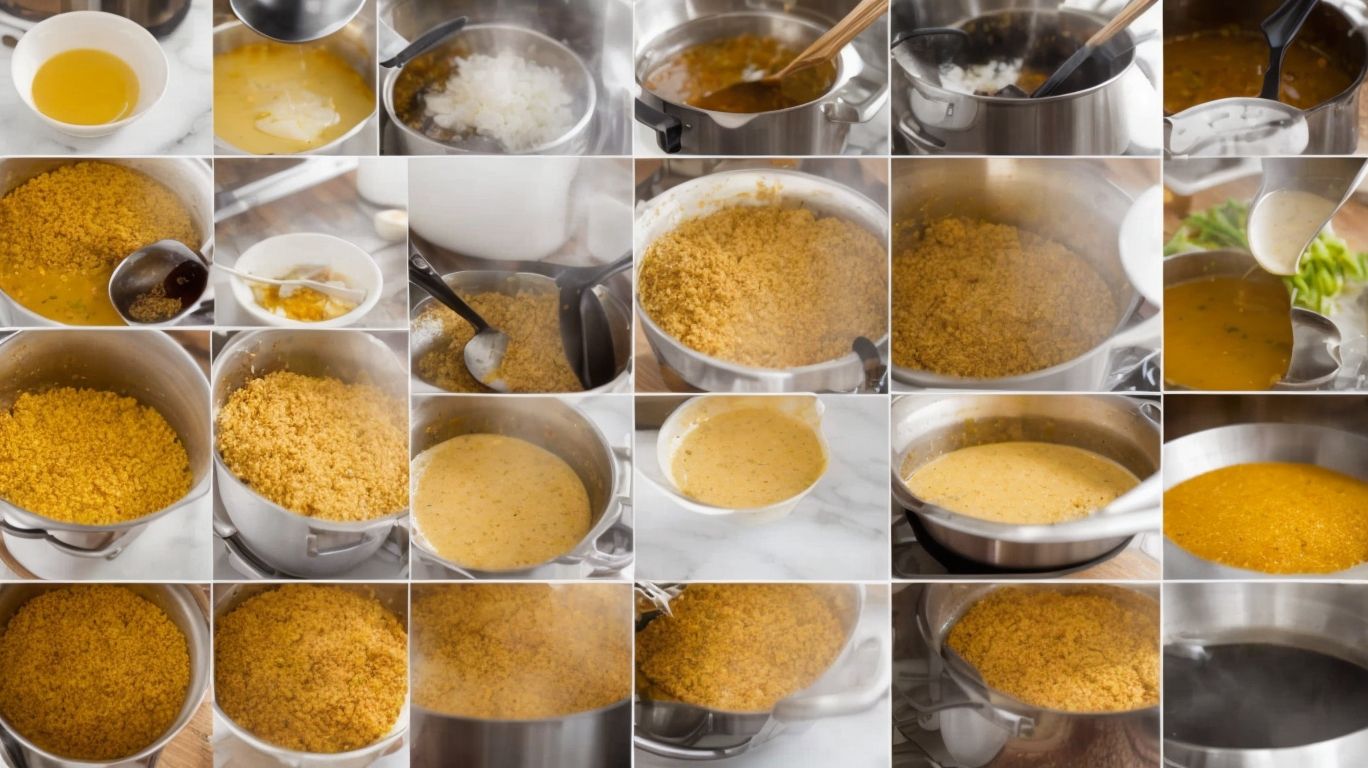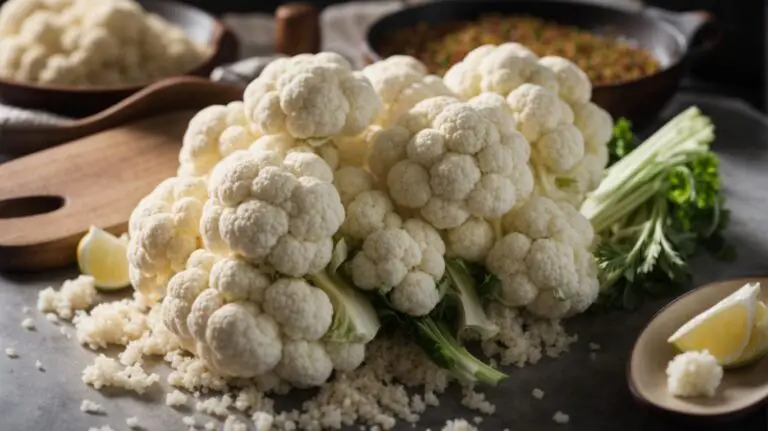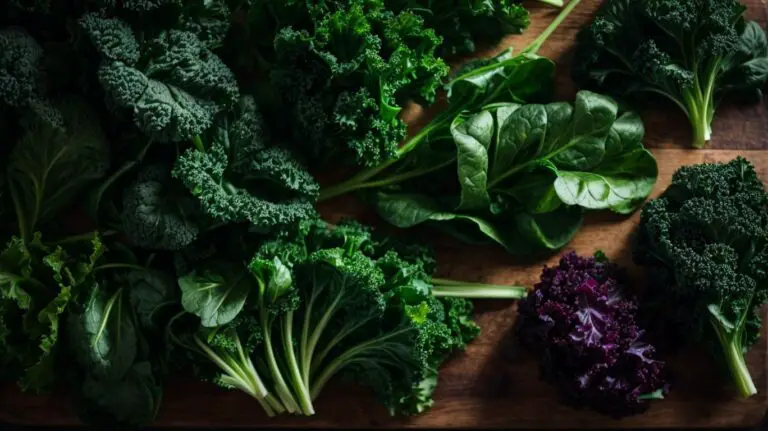How to Cook Egusi Soup Frying Method?
Looking to add a delicious and hearty Nigerian dish to your cooking repertoire? Egusi Soup is the perfect choice!
We will explore what Egusi Soup is and discuss the key ingredients needed to make this savory dish.
Dive into the step-by-step process of cooking Egusi Soup using the frying method, including tips and tricks for achieving the perfect flavor.
Whether you’re a seasoned chef or a beginner in the kitchen, this article will guide you through creating a mouthwatering Egusi Soup that will impress your family and friends. Let’s get cooking!
Key Takeaways:
What Is Egusi Soup?

Credits: Poormet.Com – Vincent Hernandez
Egusi Soup, a popular West African dish, is a rich and hearty soup known for its unique blend of flavors and ingredients.
Originally from Nigeria, Egusi Soup holds a special place in the hearts and palates of many across the region. It is a staple dish with deep cultural significance, often served at celebratory events, family gatherings, and traditional ceremonies. The soup is traditionally prepared by grinding melon seeds, also known as Egusi seeds, and blending them with a variety of local spices and leafy greens like bitterleaf or spinach.
- The diversity of ingredients in Egusi Soup contributes to its complex yet harmonious taste, ranging from savory to slightly bitter, with a hint of nuttiness from the melon seeds.
This unique combination creates a thick and flavorful broth that pairs perfectly with a side of fufu or pounded yam, making it a satisfying and wholesome meal enjoyed by many in the West African community.
What Are the Key Ingredients of Egusi Soup?
The key ingredients of Egusi Soup include a flavorful mix of Stock Fish, Palm Oil, Onions, Meat, Vegetables, and the essential Egusi Seeds.
Egusi soup is a popular Nigerian dish known for its rich and savory flavors. Stock Fish, also called dried cod or hake, adds a unique depth to the soup with its intense umami taste. The Palm Oil not only imparts a beautiful orange-red color but also infuses the dish with a distinct nutty flavor.
Onions, often sautéed at the beginning of the cooking process, provide a sweet and aromatic base for the soup. Meanwhile, different types of Meat, such as beef, goat, or chicken, contribute their own textures and flavors to the dish.
Vegetables like spinach, bitter leaf, or pumpkin leaves are commonly added to Egusi Soup, offering a burst of freshness and color. The Egusi Seeds, ground melon seeds, act as a thickening agent, giving the soup its signature creamy consistency and nutty taste.
How to Cook Egusi Soup Using the Frying Method?

Credits: Poormet.Com – Benjamin Hill
Cooking Egusi Soup using the Frying Method is a delicious and aromatic process that infuses the dish with rich flavors and textures.
The Egusi seeds are roasted till they release a nutty aroma, then ground to form a thick paste.
Next, heat oil in a deep pot and sauté finely chopped onions till golden brown. Add blended tomatoes, bell peppers, and scotch bonnet peppers for a burst of color and flavor.
Once the sauce simmers and thickens, gently stir in the Egusi paste, allowing it to fry slowly to bring out its deep earthy tones. Season generously with salt, maggi cubes, and traditional spices like thyme and curry powder.
To enhance the dish, add chunks of tender meat, smoked fish, and dried shrimp, allowing them to mingle harmoniously with the Egusi base. Cover, simmer, and let the flavors marry, creating a dish that is both comforting and deeply satisfying.
Step 1: Preparing the Egusi Seeds
The first step in cooking Egusi Soup is preparing the Egusi Seeds, which involves washing, grinding, and setting aside these essential ingredients.
Start by washing the Egusi Seeds thoroughly to remove any dirt or impurities. Place the seeds in a bowl of water and rub them between your hands to loosen any debris. Rinse them several times until the water runs clear.
Once cleaned, spread the seeds on a clean cloth or paper towel to air dry. Ensure they are completely dry before proceeding to the next step. Grinding the Egusi Seeds is crucial to achieve the desired consistency for your soup. Use a food processor or blender to grind the seeds into a smooth paste.
After grinding, store the ground Egusi in an airtight container in a cool, dry place to maintain its freshness. Properly stored, the ground Egusi seeds can last for several months, allowing you to enjoy delicious Egusi Soup whenever the craving strikes.
Step 2: Frying the Egusi Seeds
The next step in cooking Egusi Soup is frying the prepared Egusi Seeds to unlock their nutty flavor and enhance the overall taste of the dish.
When frying Egusi Seeds, it’s crucial to use a heavy-bottomed pan to prevent scorching and ensure even heat distribution. Heat a tablespoon of oil over medium heat and carefully add the seeds, stirring constantly to prevent burning.
It’s recommended to fry the seeds for about 5-7 minutes until they turn a shade darker and release a rich, toasted aroma. Be mindful not to overcook as it can lead to a bitter taste, affecting the final flavor of the soup.
Step 3: Adding the Meat and Vegetables
Once the Egusi Seeds are fried to perfection, the next step involves adding a combination of meat and vegetables to create a wholesome and flavorful Egusi Soup.
Regarding choosing the meat, options like beef, chicken, or fish work well in complementing the rich flavors of the Egusi Seeds. The meat should be cut into bite-sized pieces, ensuring even cooking and easy consumption.
On the other hand, selecting the right vegetables is crucial for adding texture and color to the soup. Popular choices typically include spinach, bitter leaf, or pumpkin leaves, chopped and washed thoroughly to remove any impurities.
Once the meat and vegetables are prepared, they are gently cooked in a pot along with the fried Egusi Seeds paste, allowing the flavors to meld together beautifully. Seasoning with stock cubes, salt, and pepper enhances the taste profile of the dish.
Step 4: Adding the Egusi Paste
Adding the Egusi Paste to the simmering soup base is a crucial step in thickening the consistency and enriching the flavor profile of the Egusi Soup.
The provided text is already properly formatted with
tags for each paragraph. No further formatting is needed.
Step 5: Simmering and Seasoning the Soup
Simmering and seasoning the Egusi Soup allows the flavors to meld together, creating a harmonious blend of tastes and aromas that define this classic dish.
Simmering is a crucial step as it helps to soften tough ingredients like meat and vegetables, making them tender and juicy. The gentle heat allows the flavors to infuse slowly, bringing out the richness of the spices and herbs in the soup.
- Seasoning, on the other hand, is what elevates the taste profile of the Egusi Soup. Adding the right amount of salt, pepper, and other seasonings enhances the natural flavors of the ingredients, creating a well-balanced and delicious final product.
Step 6: Serving and Enjoying the Egusi Soup
Serving and enjoying the aromatic Egusi Soup caps off the culinary journey with a satisfying and flavorful dining experience.
Regarding serving this traditional Nigerian dish, simplicity often wins the day. Gradually ladle the rich and creamy Egusi Soup into deep bowls, allowing the enticing aroma to fill the air.
Garnish the soup with a sprinkle of finely chopped fresh parsley or coriander for a pop of color and freshness. The vibrant green hues of the herbs will contrast beautifully with the rich orange tones of the soup.
For a textural contrast, consider serving crunchy fried plantains on the side. The sweet, caramelized flavor of the plantains pairs harmoniously with the nutty undertones of the Egusi Soup.
Tips and Tricks for Cooking the Perfect Egusi Soup
Mastering the art of cooking the perfect Egusi Soup involves key tips and tricks to enhance flavors, avoid bitterness, explore alternative ingredients, and ensure proper storage and reheating practices.
One crucial step in refining your Egusi Soup is to properly toast the melon seeds before blending them, which enhances their nutty flavor.
- Additionally, using fresh, high-quality vegetables and protein sources can elevate the overall taste and texture of the dish, so opt for locally sourced ingredients when possible.
- To prevent bitterness, soak the ground egusi seeds in warm water for about 15-20 minutes before starting the cooking process, ensuring a smoother consistency.
How to Avoid Bitterness in Egusi Soup?
Avoiding bitterness in Egusi Soup is essential for a pleasant dining experience, and key strategies include proper seed preparation, adequate seasoning, and careful cooking techniques.
One of the common causes of bitterness in Egusi Soup is the failure to properly prepare the melon seeds. To prevent this issue, ensure that the seeds are thoroughly washed before blending to remove any impurities. Balancing the seasoning by adjusting the salt and other spices incrementally while tasting can help avoid overpowering flavors that can contribute to bitterness in the soup.
What Are Some Alternative Ingredients for Egusi Soup?
Exploring alternative ingredients for Egusi Soup can offer exciting flavor variations, such as incorporating pumpkin seeds, spinach, or mushrooms to create unique culinary twists.
When considering substitutes for the traditional melon seeds, pumpkin seeds bring a nutty undertone and a slightly firmer texture, adding complexity to the dish. Spinach introduces a vibrant green color and a fresh, earthy flavor, enriching the overall profile of the soup. On the other hand, mushrooms contribute a meaty richness and an umami depth that can transform the soup into a heartier, more robust version.
These variations not only enhance the taste but also celebrate the diverse culinary influences that can be woven into this beloved West African dish. Embracing innovative ingredient swaps can lead to delightful surprises and open up a world of creative possibilities in the kitchen.
How to Store and Reheat Egusi Soup?
Properly storing and reheating Egusi Soup ensures food safety and preserves the dish’s integrity, with guidelines on refrigeration, freezing, and reheating methods.
Regarding storing Egusi Soup, opt for airtight containers to keep it fresh and prevent any odors from permeating. Glass containers or BPA-free plastic containers are ideal choices, ensuring no unwanted flavors are absorbed. Remember to let the soup cool completely before storing to maintain its quality.
Refrigeration is the best short-term storage solution, keeping the soup safe for consumption for up to 3-4 days. For longer-term storage, freezing is the way to go, with the soup retaining its flavors for up to 3 months in the freezer.
Conclusion
Egusi Soup stands as a flavorful and versatile dish that embodies the rich culinary heritage of West Africa, offering a delightful sensory experience with each savory spoonful.
Egusi Soup is not just a dish but a cultural emblem that holds a significant place in the hearts and palates of many West Africans. It represents a harmonious blend of diverse flavors and textures, making it a true culinary masterpiece. From the nutty taste of ground melon seeds to the earthy undertones of palm oil, every ingredient plays a crucial role in creating the symphony of flavors that characterize this beloved soup.
Traditionally cooked in a thick, hearty stew with vegetables, meats, or fish, Egusi Soup is a dish that brings people together around the dining table, sharing stories and laughter while savoring each comforting bite. The cooking methods vary across different regions and families, adding a personal touch to this already vibrant dish.
Frequently Asked Questions
1. How do I cook Egusi Soup using the frying method?
To cook Egusi Soup using the frying method, start by heating up oil in a pot and frying chopped onions and tomatoes until they are cooked. Add ground Egusi seeds and continue to fry until the oil separates from the mixture. Then, add meat or stock, seasonings, and any other desired ingredients before cooking on low heat for 15-20 minutes.
2. Can I use any type of oil for frying Egusi Soup?
Yes, you can use any type of oil for frying Egusi Soup. However, palm oil is the most commonly used oil in Nigerian cuisine and will give the soup a more traditional flavor. You can also use a combination of palm oil and vegetable oil for a slightly lighter taste.
3. How long does it take to fry the Egusi mixture?
The frying process for Egusi Soup typically takes about 10-15 minutes. However, the exact time may vary depending on the heat level and type of oil used. It’s important to keep an eye on the mixture and stir occasionally to prevent it from burning.
4. Can I add any vegetables to my Egusi Soup when using the frying method?
Yes, you can add vegetables like spinach, pumpkin leaves, or bitter leaf to your Egusi Soup when using the frying method. Simply add them in during the last 5 minutes of cooking to prevent them from becoming too soft or overcooked.
5. Is it necessary to add meat or stock when frying Egusi Soup?
No, it is not necessary to add meat or stock when frying Egusi Soup. However, adding these ingredients can enhance the flavor and add extra protein to the dish. If you choose not to use meat or stock, be sure to use enough seasoning to give the soup enough flavor.
6. Can I fry a large batch of Egusi Soup and freeze the leftovers?
Yes, you can fry a large batch of Egusi Soup and freeze the leftovers for later use. Allow the soup to cool completely before transferring it to a freezer-safe container. When ready to eat, simply thaw and reheat the soup on the stovetop or in the microwave.






